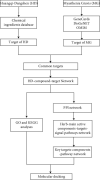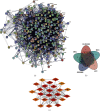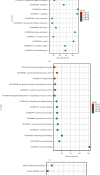Investigation of the Underlying Mechanism of Huangqi-Dangshen for Myasthenia Gravis Treatment via Molecular Docking and Network Pharmacology
- PMID: 36818231
- PMCID: PMC9935813
- DOI: 10.1155/2023/5301024
Investigation of the Underlying Mechanism of Huangqi-Dangshen for Myasthenia Gravis Treatment via Molecular Docking and Network Pharmacology
Abstract
The herbal pairing of Huangqi and Dangshen (HD) is traditional Chinese herbal medicine and has been widely used in China, especially to treat myasthenia gravis (MG). However, the mechanism of HD on MG is unclear. Aim of the Study. This study aims to investigate HD's possible role in MG treatment. Materials and Methods. The TCMSP database was used to identify the active chemicals and their targets. The GeneCards, DisGeNET, and OMIM databases were used to search for MG-related targets. The STRING database was employed in order to identify the common PPI network targets. We next utilised Cytoscape 3.8.2 for target identification and the DAVID database for gene ontology (GO) function analysis as well as Encyclopaedia of Genomes (KEGG) pathway enrichment analysis on the selected targets. The AutoDock Vina software was used to test the affinity of essential components with the hub gene before concluding that the primary targets were corrected through molecular docking. Results. 41 active compounds were screened from HD, and the number of putative-identified target genes screened from HD was 112. There were 21 target genes that overlapped with the targets of MG, which were postulated to be potential treatment targets. Through further analysis, the results showed that the active compounds from HD (such as 7-methoxy-2-methylisoflavone, quercetin, luteolin, Kaempferol, and isorhamnetin) may achieve the purpose of treating MG by acting on some core targets and related pathways (such as EGFR, FOS, ESR2, MYC, ESR1, CASP3, and IL-6). Molecular docking findings demonstrated that these active molecules have a near-perfect ability to attach to the primary targets. Conclusion. Through network pharmacology, the findings in this study provide light on the coordinated action of several HD formula components, targets, and pathways. It provided a theoretical basis for further study of HD pharmacological action.
Copyright © 2023 Miao Liu et al.
Conflict of interest statement
The authors declare that there are no conflicts of interest regarding the publication of this paper.
Figures







Similar articles
-
Integration of network pharmacology and molecular docking technology reveals the mechanism of the herbal pairing of Codonopsis Pilosula (Franch.) Nannf and Astragalus Membranaceus (Fisch.) Bge on chronic heart failure.Ann Palliat Med. 2021 Jul;10(7):7942-7959. doi: 10.21037/apm-21-1469. Ann Palliat Med. 2021. PMID: 34353081
-
Research on the Mechanism of Guizhi to Treat Nephrotic Syndrome Based on Network Pharmacology and Molecular Docking Technology.Biomed Res Int. 2021 Nov 27;2021:8141075. doi: 10.1155/2021/8141075. eCollection 2021. Biomed Res Int. 2021. PMID: 34873575 Free PMC article.
-
Exploring the pharmacological components and effective mechanism of Mori Folium against periodontitis using network pharmacology and molecular docking.Arch Oral Biol. 2022 Jul;139:105391. doi: 10.1016/j.archoralbio.2022.105391. Epub 2022 Mar 21. Arch Oral Biol. 2022. PMID: 35430443
-
Through network pharmacology and molecular docking to explore the underlying mechanism of Artemisia annua L. treating in abdominal aortic aneurysm.Front Physiol. 2022 Oct 20;13:1034014. doi: 10.3389/fphys.2022.1034014. eCollection 2022. Front Physiol. 2022. PMID: 36338468 Free PMC article.
-
Exploration of the mechanism of Zisheng Shenqi decoction against gout arthritis using network pharmacology.Comput Biol Chem. 2021 Feb;90:107358. doi: 10.1016/j.compbiolchem.2020.107358. Epub 2020 Aug 8. Comput Biol Chem. 2021. PMID: 33243703 Review.
Cited by
-
Investigation of the potential effects of estrogen receptor modulators on immune checkpoint molecules.Sci Rep. 2024 Feb 6;14(1):3043. doi: 10.1038/s41598-024-51804-2. Sci Rep. 2024. PMID: 38321096 Free PMC article.
-
Prunin: An Emerging Anticancer Flavonoid.Int J Mol Sci. 2025 Mar 16;26(6):2678. doi: 10.3390/ijms26062678. Int J Mol Sci. 2025. PMID: 40141319 Free PMC article. Review.
-
Isorhamnetin: Reviewing Recent Developments in Anticancer Mechanisms and Nanoformulation-Driven Delivery.Int J Mol Sci. 2025 Jul 30;26(15):7381. doi: 10.3390/ijms26157381. Int J Mol Sci. 2025. PMID: 40806510 Free PMC article. Review.
References
-
- Ting C. Chinese myasthenia gravis diagnosis and treatment guidelines (2020 Edition) Chinese Journal of Neuroimmunology and Neurology . 2021;28(01):1–12.
LinkOut - more resources
Full Text Sources
Research Materials
Miscellaneous

